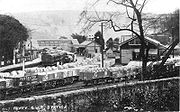
Fowey railway station
Encyclopedia

Fowey
Fowey is a small town, civil parish and cargo port at the mouth of the River Fowey in south Cornwall, United Kingdom. According to the 2001 census it had a population of 2,273.-Early history:...
to Newquay
Newquay railway station
Newquay railway station is the terminus of the Atlantic Coast Line that runs from Par railway station. It is operated by First Great Western and is situated close to the town centre and beaches in Newquay, Cornwall, England, UK.-History:...
was opened by the Cornwall Minerals Railway
Cornwall Minerals Railway
The Cornwall Minerals Railway operated a network of railway lines in Cornwall, United Kingdom. Based at St Blazey, its network stretched from Fowey to Newquay and lasted as an independent company from 1874 to 1896, after which it became a part of the Great Western Railway.-Authorisation:The...
on 1 June 1874. Fowey railway station was opened on 20 June 1876 when a passenger service was introduced, the next station being at Par
St Blazey railway station
A passenger station was opened at Par on 20 June 1876 when the Cornwall Minerals Railway started a passenger service from Fowey to Newquay. It was adjacent to the railway's workshops...
.
The station had two platforms with loading docks and a goods shed. It was situated at Caffa Mill Pill on the north side of the town by the River Fowey
River Fowey
The River Fowey is a river in Cornwall, United Kingdom.It rises about north-west of Brown Willy on Bodmin Moor, passes Lanhydrock House, Restormel Castle and Lostwithiel, then broadens at Milltown before joining the English Channel at Fowey. It is only navigable by larger craft for the last ....
. Goods trains passed through the station to the jetties where ships could be loaded directly from the wagons.
On 16 September 1895 a connection was made to the disused Lostwithiel and Fowey Railway
Lostwithiel and Fowey Railway
The Lostwithiel and Fowey Railway opened in 1869 as a broad gauge railway and links the port of Fowey in Cornwall with the Cornish Main Line at Lostwithiel...
and a passenger service introduced between Fowey and Lostwithiel
Lostwithiel railway station
Lostwithiel railway station serves the town of Lostwithiel in Cornwall. First Great Western operate the station along with every other station in Cornwall.The station is on the banks of the River Fowey in Cornwall...
. An intermediate station was opened at Golant
Golant railway station
Golant railway station was opened on 1 July 1896 by the Great Western Railway. It was a simple platform on the waterside at the south end of Golant village, next to a level crossing that gave access to a slipway....
on 1 July 1896, on the same day that the Cornwall Minerals Railway was amalgamated into the Great Western Railway
Great Western Railway
The Great Western Railway was a British railway company that linked London with the south-west and west of England and most of Wales. It was founded in 1833, received its enabling Act of Parliament in 1835 and ran its first trains in 1838...
.
The advertised passenger service to Newquay was withdrawn on 8 July 1929, although unadvertised workmen's trains continued to run until 29 December 1934.
The Great Western Railway was nationalised into British Railways on 1 January 1948. The passenger service to Lostwithiel was withdrawn on 4 January 1965 and the remaining goods traffic from Par ceased on 1 July 1968. The railway was then converted into a private road to bring china clay
Kaolinite
Kaolinite is a clay mineral, part of the group of industrial minerals, with the chemical composition Al2Si2O54. It is a layered silicate mineral, with one tetrahedral sheet linked through oxygen atoms to one octahedral sheet of alumina octahedra...
from Par harbour
Par, Cornwall
Par is a town and fishing port with a harbour on the south coast of Cornwall, England, United Kingdom. The town is situated in the civil parish of Tywardreath and Par and is approximately east of St Austell. Par has a population of around 1,400.....
.
The station has been demolished and the site is now a car park, although some of the original buildings remain. Trains of china clay still operate from Lostwithiel to a jetty at Carne Point, a little further up the river.

